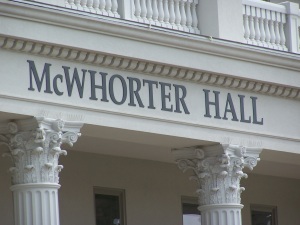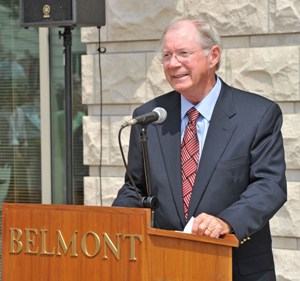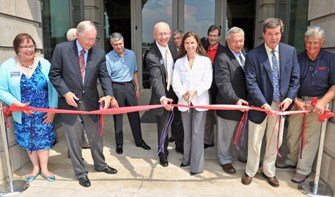 Belmont University celebrated the grand opening of the new 90,000 square foot McWhorter Hall at a ribbon cutting event held on campus Saturday. The state-of-the-art academic building houses the Schools of Pharmacy and Physical Therapy, as well as the Department of Psychological Science. McWhorter Hall is being named in honor of Belmont Trustee Emeritus and Chairman of Clayton Associates, Clayton McWhorter, and his brother, the late pharmacist Fred McWhorter. Both men dedicated their careers to the healthcare field, making a difference in the lives of countless individuals and championing healthcare reform. In addition to his longtime relationship with the University and his work on the School of Pharmacy’s initial Study Team and External Advisory Committee, Clayton is also providing a major leadership gift in support of Belmont’s new academic building.
Belmont University celebrated the grand opening of the new 90,000 square foot McWhorter Hall at a ribbon cutting event held on campus Saturday. The state-of-the-art academic building houses the Schools of Pharmacy and Physical Therapy, as well as the Department of Psychological Science. McWhorter Hall is being named in honor of Belmont Trustee Emeritus and Chairman of Clayton Associates, Clayton McWhorter, and his brother, the late pharmacist Fred McWhorter. Both men dedicated their careers to the healthcare field, making a difference in the lives of countless individuals and championing healthcare reform. In addition to his longtime relationship with the University and his work on the School of Pharmacy’s initial Study Team and External Advisory Committee, Clayton is also providing a major leadership gift in support of Belmont’s new academic building.
Belmont President Dr. Bob Fisher said, “This building is a model, 21st century academic facility that will provide the perfect space and environment where our students and faculty can intersect in service to help meet the medical needs of our community and our world. We are honored to have the McWhorter name on the building, knowing that it will endow this space with a legacy of compassionate, professional care for others that our students will be equipped to emulate.”
 Clayton McWhorter added, “My brother Fred practiced pharmacy like it should be practiced and stayed true to his profession for more than 50 years, loving every minute of it. I believe he would be honored to have this building bear the McWhorter name, but I’m even more hopeful that the student pharmacists and other health care specialists learning within these walls will look to my brother as a premier model of their profession.”
Clayton McWhorter added, “My brother Fred practiced pharmacy like it should be practiced and stayed true to his profession for more than 50 years, loving every minute of it. I believe he would be honored to have this building bear the McWhorter name, but I’m even more hopeful that the student pharmacists and other health care specialists learning within these walls will look to my brother as a premier model of their profession.”
Pharmacy Care Center, Health Services Center, Drug Information Center and Pharmacy Labs
Designed by Earl Swensson Associates with construction by R.C. Mathews, McWhorter Hall continues the innovation for which Belmont University has become known. The facility will emphasize integrated, “hands on” experiential learning components including a licensed, state-of-the-art Pharmacy Care Center which will provide services to students, faculty and staff while also serving as a training site for student pharmacists. This first floor “living laboratory,” which is located adjacent to Belmont’s expanded Health Services center, will help student pharmacists learn every aspect of opening and running a retail pharmacy business. Clients of the pharmacy will be offered personal service in a managed care environment.
The second floor of McWhorter Hall also offers numerous spaces to serve pharmacy students’ needs. In the pharmacy lab, student pharmacists will be making various pharmaceutical products (ointments, powders, creams, etc.), while the Drug Information Center serves the faculty and student pharmacists with a state-of-the-art area to search, assimilate, and transfer information to health care providers that is up to date and patient specific. The center also provides educational programs for post graduate pharmacists from area hospitals. Pharmacy faculty laboratories in the building provide over 5,500 square feet for discovery, innovation and education. Faculty will immediately begin work on projects providing safer, better pharmaceuticals and insight and treatment approaches for various central nervous system diseases, human cell malformations and cancers, therapies for the eye, and improved formulations for pharmaceuticals.
Dr. Phil Johnston, dean of the School of Pharmacy, said, “This new facility is a dream come true for Belmont University, our faculty and for our student pharmacists. It is a privilege to work in this environment and with these bright young professional people. Here, we are able to provide a top notch educational program that prepares student pharmacists to succeed in the world of pharmacy.”
Additional Lab Spaces for Interdisciplinary Education
Also housed within McWhorter Hall are a variety of laboratory spaces dedicated to permitting research and educating future occupational therapists (OT) and physical therapists (PT). Specifically, the first floor is a joint OT/PT Health and Wellness Lab that contains state-of-the art research equipment that spans balance assessment, strength (torque) evaluation, driving simulation, virtual reality exercise activities, work simulation and whole body vibration. The second floor is a joint Human Performance Lab I, with work hardening equipment and the facilities needed to teach a variety of hands-on classes. The third floor contains the Human Performance Lab II, a joint lab space designed for instruction and hands-on evaluation and treatment activities.
 The fourth floor houses two labs, a Gross Motor Skills Lab and a Motion Analysis Lab. The Gross Motor skills lab is designed to allow OT and PT students to assess and treat patients with a variety of movement disorders and low vision. The Physical Therapy Motion Analysis Lab permits three-dimensional evaluation of movement, coupled with telemetried electromyographic data (can tell when muscles turn on and off), and motion analysis as assessed through a force plate. Collectively, these five lab spaces provide OT and PT graduate students with the resources that they need to critically evaluate a wide range of health related dysfunctions and become therapists that are able to meet future health care needs.
The fourth floor houses two labs, a Gross Motor Skills Lab and a Motion Analysis Lab. The Gross Motor skills lab is designed to allow OT and PT students to assess and treat patients with a variety of movement disorders and low vision. The Physical Therapy Motion Analysis Lab permits three-dimensional evaluation of movement, coupled with telemetried electromyographic data (can tell when muscles turn on and off), and motion analysis as assessed through a force plate. Collectively, these five lab spaces provide OT and PT graduate students with the resources that they need to critically evaluate a wide range of health related dysfunctions and become therapists that are able to meet future health care needs.
Of special note are McWhorter Hall’s simulation labs, where students and community clinicians can practice skills either on actors who simulate patients or on high tech manikins; this simulation suite is interdisciplinary, and programs will be encouraged to work in simulated scenarios that involve several health disciplines.
Dr. Jack Williams, dean of Belmont’s College of Health Sciences and Nursing, said, “McWhorter Hall provides inter-professional education opportunities for all of our students, preparing them to be both competent and compassionate practitioners.”
Building’s ‘Green’ Features
In addition to the educational influence, the building’s innovations also serve to complement Belmont’s efforts toward environmental sustainability. For starters, the building’s four-level underground parking garage reduces the structural footprint, saving four acres of land that would have been lost to surface parking. The building’s total footprint, including the garage, is less than an acre. Another significant “green” feature is the 20,000 gallon water storage tank, which has the ability to capture excess ground and storm water that would otherwise be pumped into the storm system. The collected water will be recycled and used to irrigate the campus. The new building also features a green roof which mimics a cedar glade with a wide variety of plant life.
